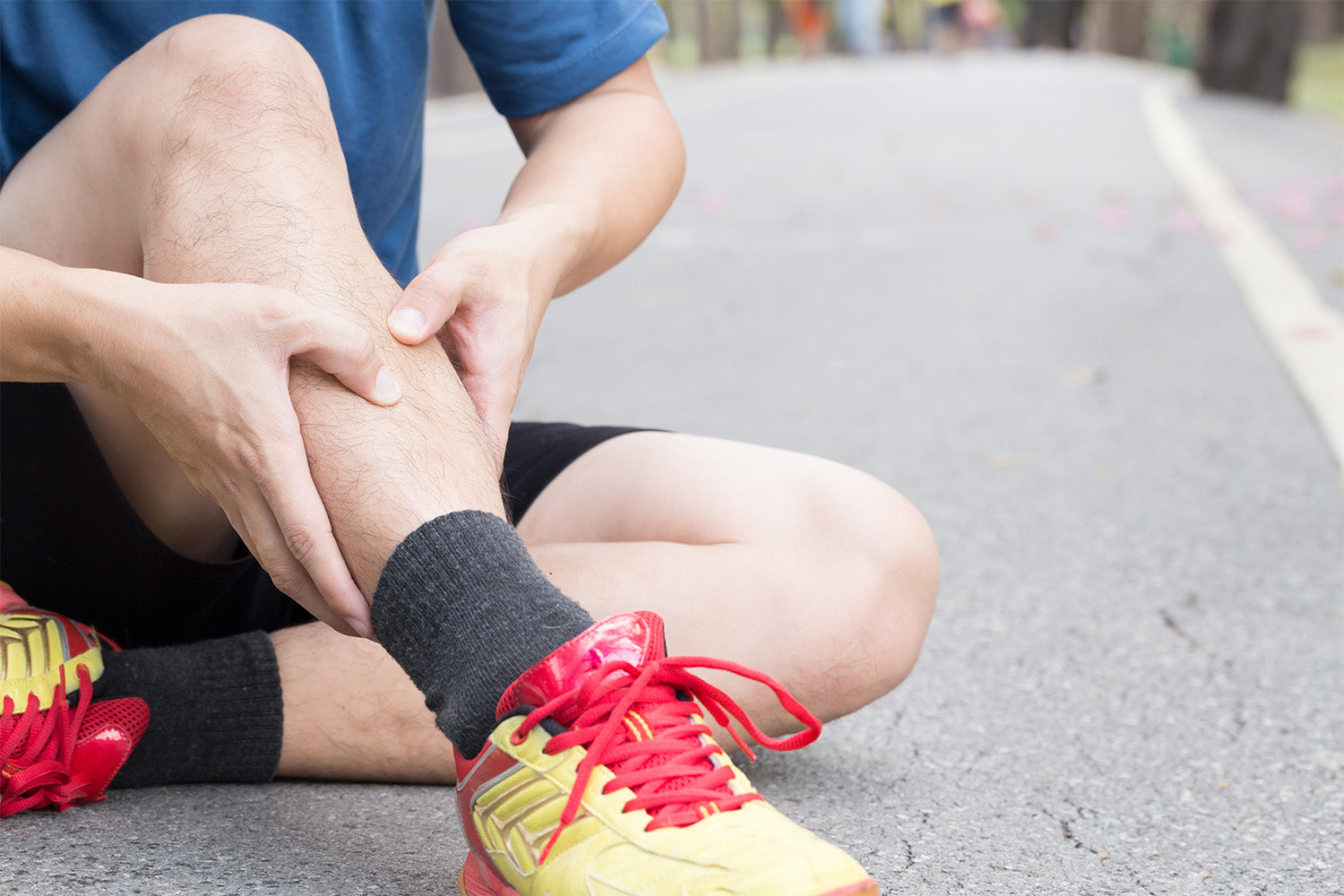Medically Reviewed By | Johannah Gregg, DNP FNP-C
Pain in your lower leg or shin can quickly cause enough discomfort to throw off your whole exercise. On top of being uncomfortable, shin pain can also affect your form in other exercises and gait, so it is vital to address it immediately.
Understanding the causes and potential treatments of shin pain will help you make the most of your exercise and keep yourself from pausing your routine.
What Causes Shin Pain?
As frustrating as shin pain can be, it is usually not too hard to narrow down the cause. Consistent pain in the front of your lower leg is usually the result of one of two conditions—shin splints or, in more severe cases, stress fractures.
Shin Splints
Shin splints, known scientifically as medial tibial stress syndrome (MTSS), are the most likely culprit for shin pain. Athletes who engage in repetitive physical activity are at higher risk of shin splints. MTSS causes pain in the inner part of the shin bone or tibia. This pain is likely due to the inflammation of the tissues that connect your leg muscles to the tibia.
Shin splints are usually the result of overuse and are common sports injuries. Running and jumping are the two most common reasons for developing MTSS. However, repetitive activities are not guaranteed to end in shin splints. In many cases, injury results from poor form, inadequate warm-up and stretching, or exercising too frequently.
Johannah Gregg, DNP, FNP-C advises that if you have trialed conservative measures such as ice and heat, rest and reduction of repetitive activity, and anti-inflammatory medications, and you continue to suspect shin splints or a more severe issue, you should talk to your healthcare provider about the next steps.
Shin splints are typically harder to diagnose than other issues because they do not show up on an x-ray. But your doctor can help you determine other potential reasons for your discomfort.
Stress Fracture
If your lower leg pain isn’t the result of shin splints, it is probably the result of more serious injury — stress fractures. A stress fracture is a small, thin break in your shin. Like shin splints, stress fractures occur due to repetitive, high-impact exercise.
You can usually tell stress fractures apart from shin splints if you have consistent pain outside physical activity and during rest. Pain from stress fractures is more specific to one area instead of generalized. Your doctor will be able to identify stress fractures with an x-ray.
The recovery period for stress fractures is longer than for shin splints, often lasting between four and twelve weeks.
How Do I Avoid Shin Splints?
Unfortunately, we often don’t think about avoiding shin pain until it happens. However, taking a mindful approach to your routine can make a significant difference in minimizing your risk.
Avoid High-Impact Exercises
One of the best ways to reduce your risk for injury is to move away from harsh high-impact activities, like running on pavement. If you want to avoid shin splints or find a way to work around them, you should try alternative activities like biking or swimming.
These options put less stress on your shins while giving you a great workout opportunity. Cross-training helps limit the disappointment of not being able to run — Dr. Gregg also notes that it promotes strengthening all muscle groups instead of over use of limited muscles.
If you enjoy running, you should find a way to run while avoiding hard surfaces, and ensure appropriate footwear. Finding a track with a softer material or running on a gravel surface can go a long way toward reducing the impact on your shins and calves.
Check Your Form
Improper form can quickly turn into pain, especially with repetitive motions like running or jumping during sports. Having someone like a trainer or fellow athlete critique your form can be valuable in helping you avoid any injury.
Before rushing into your exercise, stretching is vital, which will help you relieve any unnecessary tension in your muscles, warm up your muscles, and increase your ability to maintain proper form.
You may also need to second-guess your gear. Sometimes finding more shock-absorbent running shoes, insoles, or arch supports is enough to do the trick.
How Do I Find Relief from Shin Pain?
Shin pain is one of the most nagging injuries, especially when it prevents you from doing what you love. Fortunately, shin pain is rarely permanent as long as you develop the proper approach to relieving the injury and avoiding re-injury. However, you may take a slight pause in your exercise routine before finding some relief.
Rest
As with any injury, rest is the first and best step on the road to recovery. Steering clear of activity is the best way to calm the inflammation and allow any damaged tissues to heal. You can provide extra support during the resting process by applying ice and raising your leg above your chest while lying or sitting down.
Before returning to the activity, you should ensure that you are fully recovered and pain-free. You should never try to power through the pain, as this may only worsen the problem.
Gregg recommends gradually rebuilding your stamina and strength to prevent re-injury.
If your soreness keeps you from relaxing, you can try some over-the-counter pain relievers like ibuprofen.
Talk to a Professional
If you can’t seem to find relief for your shin pain no matter what you do, then you may be able to benefit from some professional advice from your healthcare provider. After resting the injury to settle the inflammation, you may benefit from working with a physical therapist.
Physical therapy can help you take the stress off your shins by strengthening surrounding muscles. The process can also help you work on your exercise form to ensure you are not putting unnecessary pressure on any part of your body. A little sports medicine can go a long way.
You may also have flat feet, a high arch, or another structural issue. In this case, a physical therapist or orthopedic doctor may recommend orthotic inserts for your athletic shoes to help correct the issue and reduce the pain of shin splints.
Incrediwear Sleeves
Sometimes, you only need a little support when you want to return to your activity level. With Incrediwear, you can gain valuable support to prevent yourself from being sidelined long-term.
By using semiconductor technology inside a comfortable, well-fitted sleeve, Incrediwear helps to boost your circulation, which promotes the natural healing process and minimizes your risk for re-injury. Incrediwear offers sleeves and braces, which are great for providing more stability and support while running or playing sports.
Don’t Miss a Beat On Your Training
Shin pain is no joke and can keep you from doing the activities you love. However, adjusting your activity and following the right recovery process can be a game-changer, and Incrediwear is here to help prevent and recover.
The next time you put on your running shoes or jump back on the court, put on an Incrediwear ankle sleeve. The extra support can make a key difference in protecting your shins from future pain. Incrediwear also features a list of other products to support you while running or exercising, from hip braces to sports socks.
Explore our complete inventory of running products and see how Incrediwear can help you in your next workout.
Sources:
Medial Tibial Stress Syndrome - (Shin Splints) | Columbia Orthopedic Surgery
Stress Fractures: Causes, Symptoms, Tests & Treatment | Cleveland Clinic
Stress Fracture or Shin Splints? How to tell the difference | UChicago Medicine
Read more

Please note that this post is provided for informational purposes only and should not be taken as medical advice. If you have any concerns please consult an appropriately qualified medical profess...

Please note that this post is provided for informational purposes only and should not be taken as medical advice. If you have any concerns please consult an appropriately qualified medical profess...






Leave a comment
All comments are moderated before being published.
This site is protected by hCaptcha and the hCaptcha Privacy Policy and Terms of Service apply.